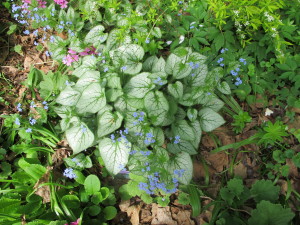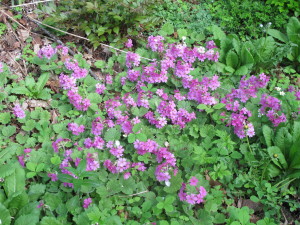Pondering a Few Perennial Flowers
I aspire to be the Goatsbeard King of Cornish Flat. Maybe I already am. I have several, and no one else I know here grows goatsbeard (Aruncus dioecious). It is one of many flowers I grow that do well in light shade, getting bigger and better every year, and requiring very little of me.
Long ago, decades ago, I bought my first goatsbeard. The plant tag said it would grow in shade, so I foolishly planted it under a Canadian hemlock. It survived, but never bloomed. In terms of sunshine, planting it there was akin to planting it in under a box– virtually no light; additionally, there was lots of root competition from the tree. Then after 10 years I moved it to a place that got nice morning sun, but no afternoon sun. It bloomed and thrived, which taught me to move plants that aren’t thriving.
Goatsbeard blooms in early summer with tall plumes of fluffy white flowers (similar to astilbe flowers) rising above its tall foliage. There are male plants and female plants, though honestly I do not know which is which. (It’s not like puppies, where you just lift up the tail and look). Books tell me the males are showier. The leaves on mine are 3 to 4 feet tall and the clumps get bigger every year. I also have a miniature goatsbeard (A. aethusifolius) that is very nice and compact, and stays just 8 to 15 inches tall and has small white spikes of delicate white flowers that, like its big brother, stand above the foliage.
There are many kinds of shade. Most perennials that grow in shade need some sunshine filtered through canopy of leaves, not an umbrella of shade from evergreens. Morning sun that washes a plant for a few hours early in the day is fine for a shade plant but hot afternoon sun generally is too much. And if a plant is rated for use in the shade, moist soil will usually help it thrive if it gets more direct sun than it would like (otherwise it would dry it out in the sun).
One of my favorite flowers is blooming everywhere right now for me. Forget-me-nots (Myosotis sylvatica) have small 5-petaled light blue flowers on 8- to 15- inch stems, though I have a few with white or pink flowers. They spread by seed, creating waves of color in shade or part shade locations, or even in sunny places. These plants are never a problem: if one pops up somewhere that is designated for another plant, it is easy to remove as its roots are not at all tenacious. It is not clear from the literature if forget-me-nots are annuals, biennials or perennials. If perennials, they are short-lived ones.
A perennial with flowers nearly identical to forget-me-nots is Siberian bugloss, more commonly called Brunnera, which is its Latin name (Brunnera macrophylla). A named cultivar, “Jack Frost’, is one of the most common. The leaves are smaller than the standard species leaves, and are “frosted” with white. The leaves are heart-shaped and very handsome all summer. Any plant with variegated leaves – those that have a lack of green chlorophyll in parts – tend to be smaller and less vigorous, as the white portions do not produce food for the plant.
Primroses are in bloom for me now and are some of my favorites. One with no common name is Primula kisoana, a brilliant magenta flower that spreads nicely by root, but never overpowers other plants. It likes shade and will grow in dry or moist soil. I even have it growing on a rock ledge that only has an inch of soil and it is happy there, too.
Another great primrose is the Japanese primrose (Primula japonica). This is also called the candelabra primrose because it displays 3 or more tiers of umbels (umbrella-shaped clusters of flowers) separated by a few inches of stem. These need moist or even wet soil and do well for me under apple trees in rich, black soil. Most primroses seem to like growing under apples. This one blooms just after P. kisoana, providing continuous color for 4 to 6 weeks between them.
Since early April – and continuing into June – I have had hellebores blooming in dry shade. Also called Lenten rose (Helleborus orientalis), these have handsome evergreen leaves and 2- to 3-inch diameter five-petaled flowers. The flowers are good looking even when past their prime (like many gardeners I know). I have them growing in dry soil in a shady location that gets a little morning sun. If you haven’t tried them, you should. Their colors range from white to deep maroon, and hybrids now come in doubles (with extra petals). ‘Peppermint Ice’ is a very nice double hybrid.
In that same bed with the hellebores I have some very nice anemones, one called Anemone nemorosa. Not all anemones are nice, however. There is a common one often found at plant sales called Canadian or meadow anemone (Anemone canadensis). It has a pretty white flower, but spreads too quickly and cannot be easily removed or controlled. A thug. But A. nemorosa stays in nice clumps with 1-inch lavender or white blossoms on 6 inch stems. Fall blooming Japanese anemones (A. x hybrida) are wonderful, too.
An easy shade-blooming ground cover is spotted deadnettle (Lamium maculatum). It has small pink-mauve flowers on square stems, but the flowers are not showy. It will spread quickly. Its foliage is 6- to 8-inches tall and each leaf has a white stripe up the middle.
Shade is too often neglected by gardeners. There are so many flowers that will thrive there, you really must try some new ones this year. Head for your local family-owned nursery and see what grabs your fancy. And who knows? Maybe you’ll come home with goats (beard)!
Henry Homeyer is a gardening consultant and author. His web site is www.Gardening-Guy.com.





